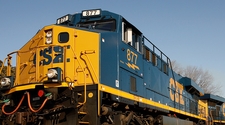National Bargaining Q&A
Updated October 6, 2011
Background:
National bargaining with the 13 unions that represent railroad employees has been going on since January of 2010. While the railroads reached an agreement in early September with the largest union – the United Transportation Union (UTU) representing yardmasters and conductors -- negotiations with the remaining unions reached an impasse on September 7 – with the parties fairly far apart on issues related to health care and wages. Although the railroads were willing to agree to binding arbitration, the unions refused.
The National Mediation Board, which oversees the negotiations, ordered a “cooling off period” and asked the White House to appoint a Presidential Emergency Board (PEB), which will invite all parties to present their statements and will later make a non-binding recommendation for an agreement.
The PEB was appointed on October 6; with hearings likely to begin the week of October 17 and last through October 21. We expect the PEB recommendation by November 6.
Who represents management at the negotiating table?
Management is represented by the National Carriers’ Conference Committee (NCCC), which consists of the labor vice presidents from Union Pacific, Burlington Northern Santa Fe, CSX Transportation, Norfolk Southern and Kansas City Southern. The spokesperson for the NCCC is the chairman of the National Railway Labor Conference (NRLC).
How about the unions?
The unions are organized into three coalitions. Each coalition is bargaining separately with the NCCC. The United Transportation Union that includes yardmasters and conductors has ratified their agreement, but the other two coalitions are:
- The TCU -- The Transportation Communications Union includes the TCU, Brotherhood of Railway Carmen, International Association of Machinists, Transportation Workers Union, American Train Dispatchers Association, and International Brotherhood of Electrical Workers; and
- The RLBC -- The Rail Labor Bargaining Coalition includes the Brotherhood of Maintenance of Way Employees, Brotherhood of Railway Signalmen, Brotherhood of Locomotive Engineers, Sheet Metal Workers International Union, National Conference of Firemen and Oilers, and International Brotherhood of Boilermakers.
What are the issues holding up an agreement?
As always, wages are an area of significant disagreement. The NCCC’s most important non-wage issue is health care. And both the RLBC and TCU have other issues that are significant to their agendas.
What is a Presidential Emergency Board (PEB) and what do they do?
President Obama has appointed 5 people to the PEB – they are:
Ira Jaffe, Chair; Gil Vernon; Josh Javits; Arnold Zack and Roberta Golick.
The PEB’s job is to listen to all parties’ positions in a series of public hearings and to then convene privately to develop a non-binding recommendation for settlement. They have 30 days to issue their recommendation. The PEB, in its discretion, may also attempt to mediate the dispute during the 30 days it has jurisdiction.
What happens after the PEB makes its recommendation?
Following the PEB recommendation – which we expect on approximately November 6 -- the parties resume negotiations and enter a second 30 day cooling off period. At the end of the second cooling off period, the parties either reach a settlement or are free to strike, lockout or unilaterally implement new contract provisions if there is no agreement. The last cooling off period, if necessary, would end on approximately December 6.
How likely is some sort of strike, lockout or work stoppage after the PEB convenes?
The Railway Labor Act prohibits any strikes or lockouts while the PEB is in place, or during any of the cooling off periods.
The earliest realistic opportunity for any strike or lockout in this bargaining process would occur in early December -- after the PEB is appointed, after they complete their hearings and after a second cooling off period. However, if a strike or lockout is called, Congress is likely to step in, preventing any prolonged disruptions.
During the last 20 years, there have been only two days of legal strike activity at the major freight roads, so a strike or lockout is not likely at this point in time. During the last round of bargaining, RLBC reached the first settlement, setting the pattern for other unions to follow. This time UTU has set the pattern and with some creativity and compromise, the other unions and the NCCC should be able to reach a settlement. In the event that a strike or lockout were to occur, Congress can be expected to step in. Given the uncertain atmosphere in Washington, Congressional intervention is not the preferred solution.
Hasn’t one of the unions already threatened to strike?
One union – the Brotherhood of Locomotive Engineers and Trainmen (BLET) – announced that it has taken and received a strike vote. This is not unusual at the late stages of negotiations. Neither the BLET nor any other union involved in negotiations is legally free to strike until much later point in the process.
Aggressive public statements are not unusual at this point in bargaining as the unions attempt to bargain the best deal they can and demonstrate the support of their members.
What is CSX’s position on the negotiations?
We believe that the wage and benefit package in the UTU agreement is fair, equitable, and reflects market conditions, providing a 17% increase in wage rates, maintaining comprehensive benefits and implementing changes in plan design for medical and prescription coverage that enable us to freeze employee contributions to benefits for five years.
Providing market-based wage and benefit increases allow the railroads to compete fairly with trucks for the growing freight transportation market. It enables CSXT to maintain our infrastructure and grow our business, which adds jobs and allows the company to achieve its long-range strategic objectives, all while providing efficient and environmentally-friendly transportation solutions.
The railroad business is a high cost, capital intensive business. CSXT has invested heavily in capital improvements, spending over $2 billion this year on maintaining and improving track, buying new locomotives and cars, and investing in technological advances. These expenditures are good for business and create jobs for our employees. Positive train control, a program ordered by the federal government, is projected to cost CSXT at least $1.2 billion by 2015. By the government’s own estimates, PTC will cost about 22 times the benefit it will yield.
To put employee wages and benefits into perspective, each year CSXT spends approximately $2.4 billion on employee wages, health care and other benefits. That’s more than we spend on capital improvements. Employees are human capital; our most important form of capital, so that money is well spent on you. By 2015, a 17% wage increase, applied to all CSXT contract employees will cost more than $340 million beyond current wage costs. When expected health care inflation is added, the cost increase exceeds half a billion.
CSXT believes that we have productive, hardworking employees who should be well paid. At the same time, it would be irresponsible to our shareholders and our employees to agree to wage and benefit demands that are excessive.

















